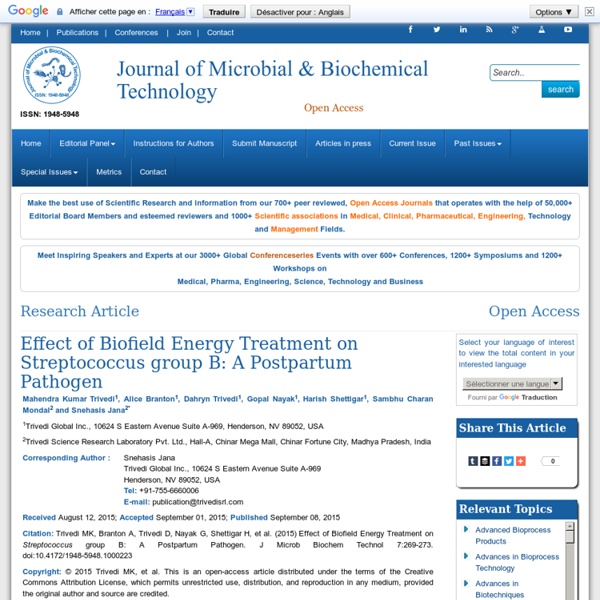



Effect of Biofield Energy Treatment on Streptococcus group B: A Postpartum Pathogen *The embed functionality can only be used for non commercial purposes. In order to maintain its sustainability, all mass use of content by commercial or not for profit companies must be done in agreement with figshare. Description Streptococcus agalactiae group B (S. agalactiae gr. B) is widespread in nature mainly causes bacterial septicemia and neonatal meningitis.
"An Effect of Biofield Treatment on Multidrug-resistant Burkholderia ce" by Mahendra Kumar Trivedi Abstract Burkholderia cepacia (B. cepacia) is an opportunistic, Gram negative pathogen which causes infection mainly in immunocompromised population and associated with high rate of morbidity and mortality in cystic fibrosis patients. Aim of the present study was to analyze the impact of biofield treatment on multidrug resistant B. cepacia. Clinical sample of B. cepacia was divided into two groups i.e. control and biofield treated.
Evaluation of Phenotyping and Genotyping Characteristic of Shigella sonnei after Biofield Treatment Abstract Shigella sonnei (S. sonnei) is a non-motile, rod shape, clinically significant, Gram-negative bacterium. It is commonly associated with dysentery (shigellosis). Recently, resistance to third and fourth generation cephalosporins and fluoroquinolones has been reported in S. sonnei. In the present study, we assessed the effect of biofield treatment on phenotyping and genotyping characteristic of S. sonnei (ATCC 9290).
"Antibiogram, Biochemical Reactions and Genotyping Characterization of Description Staphylococcus aureus (S. aureus) is the key organism for food poisoning due to massive production of heat stable exotoxins. The current study was attempted to investigate the effect of Mr. Trivedi’s biofield treatment on S. aureus. S. aureus (ATCC 25923) was divided into two parts, Group (Gr.) I: control and Gr.
Human Biofield’s Influence on Properties of Indole Abstract Indole compounds are important class of therapeutic molecules, which have excellent pharmaceutical applications. The objective of present research was to investigate the influence of biofield treatment on physical and thermal properties of indole. Evaluation of Antibiogram, Genotype and Phylogenetic Analysis of Biofield Treated Nocardia otitidis Title: Evaluation of Antibiogram, Genotype and Phylogenetic Analysis of Biofield Treated Nocardia otitidis Publication:
Bio-field Treatment: A Potential Strategy for Modification of Physical and Thermal Properties of Gluten Hydrolysate and Ipomoea Macroelements Share this: Embed* Cite this: Trivedi, Mahendra Kumar (2015): Bio-field Treatment: A Potential Strategy for Modification of Physical and Thermal Properties of Gluten Hydrolysate and Ipomoea Macroelements. figshare. Retrieved 09:31, Nov 18, 2015 (GMT) *The embed functionality can only be used for non commercial purposes.
Mahendra Kumar Trivedi (0000-0002-2548-780X) - ORCID Mahendra Kumar Trivedi completed his 5-year Bachelor’s degree in Mechanical Engineering in 1985 and had worked as an Engineer for 10 years. In 1995, Mr. Trivedi discovered his unique ability to harness the energy from the universe and transmit it to anywhere on the globe, infusing it into living organisms and nonliving materials, thus optimizing their potential.
Biofield Treatment’s Impact on Metronidazole & Tinidazole Abstract Metronidazole and tinidazole are widely used antimicrobial drugs against Gram-negative and Gram-positive anaerobic bacteria. The present study was aimed to evaluate the impact of biofield treatment on metronidazole and tinidazole using FT-IR and UV spectroscopy. The study was carried out in two groups i.e. control and treatment.
Mahendra Kumar Trivedi Mahendra Kumar Trivedi earned his 5-year Bachelor’s degree in Mechanical Engineering in 1985 . Mahendra Kumar Trivedi worked as an Engineer for 10 years. In 1995, Mr. Spectroscopic Characterization of Disulfiram and Nicotinic Acid after Biofield Treatment Trivedi, M. K. (2015), 'Spectroscopic Characterization of Disulfiram and Nicotinic Acid after Biofield Treatment'. %0 Thesis %1 mahendrakumartrivedi %A Trivedi, Mahendra Kumar %B Spectroscopic Characterization of Disulfiram and Nicotinic Acid after Biofield Treatment %D 2015 %I Mahendra Kumar Trivedi %J Analytical & Bioanalytical Techniques %K biofield mahendrakumartrivedi myown %N 5 %T Spectroscopic Characterization of Disulfiram and Nicotinic Acid after Biofield Treatment %U %V 6 %X Disulfiram is being used clinically as an aid in chronic alcoholism, while nicotinic acid is one of a B-complex vitamin that has cholesterol lowering activity. The aim of present study was to investigate the impact of biofield treatment on spectral properties of disulfiram and nicotinic acid.
Antibiogram, Biochemical Reactions and Genotyping Characterization of Biofield Treated Staphylococcus aureus Title: Antibiogram, Biochemical Reactions and Genotyping Characterization of Biofield Treated Staphylococcus aureus Publication: American Journal of BioScience Select license: